04 Apr 2021 Healthy Soils Field Day Overview Report
3 April 2021
The Australian Olive Association (AOA) has convened a series of 6 of ground-breaking field days across Australia. The field days emphasised the important role of healthy soils in producing healthy trees and lifting grove productivity.
At Lentara Grove, Exeter, TAS.
A small but enthusiastic group of 12 olive producers representing 9 Tasmanian olive groves attended a very successful field day hosted by EVOO and table olive producers Martin & Sophie Grace at Lentara Grove situated in the Tamar Valley at Exeter.
Participants travelled from across Tasmania including Flinders Island and the Tamar Valley in the north to the Huon Valley and Bruny Island in the south of the state.
Lentara Grove is one of Tasmania’s oldest olive groves, located in Tasmania’s beautiful Tamar Valley, near Exeter, 30 minutes north of Launceston. In 2015 Lentara Grove came up for sale, offering over 700 mature olive trees on 20 hectares and with established processing facilities onsite. Martin and Sophie Grace seized the opportunity. Despite both having desk jobs, the couple learnt the ropes of olive growing and pressing, and quickly turned their new hobby into a thriving business. Their small grove of 24 year old trees is located on a north-facing slope on a ridge above the Tamar River – this site provides generous amounts of sunlight to ripen the olives to perfection as well as the perfect soil conditions to keep the trees happy.
Download the Lentara Grove field day report here
At Nangkita Grove, SA.
An enthusiastic gathering of more than 30 olive producers representing 20 South Australian olive groves attended a very successful field day hosted by EVOO and table olive producers Melanie Hollock and Brook Wyett located on the famous Fleurieu Peninsula (Foodies Paradise), where Mel and Brook farm 2 groves, the first Peninsula Providore Farm is at Currency Creek, and Nangkita Grove which is located at Tooperang near Mount Compass, acquired in 2019.
The Nangkita Grove was established by the previous owner at a similar time to Mel and Brook’s grove at Currency Creek, however Nangkita Grove boasts a larger range of varieties, and now has around 17,000 Olive trees across 7 cultivars: Frantoio, Manzanillo, Kalamata, Leccino, Barnea, Pendolino, Koroneiki, Mel and Brook are continuing to bottle under the Nangkita label, making this Extra Virgin Olive Oil in a milder style than their premium Peninsula Providore Range.
SA Field day participants travelled from as far as Broken Hill, NSW, Limestone Coast, Murraylands, Adelaide Hills, Northern Adelaide Plains, Barossa Valley, Mid North, and Yorke Peninsula.

SA field day participants declared it ‘great day’ providing ‘practical information’ for olive growers.
Nangkita Grove owners Mel and Brook have already commenced a major pruning renewal program of their 17,000-trees, and are now even more convinced of the value of in-grove mulching of the prunings to return valuable carbon and nutrients to the soil.
They will also be ramping up last year’s composting of their processing waste with other organic matter (particularly with a greatly increased crop on the trees, and therefore greater oil production this year), and are keen to trial the use of biological products to increase microbial soil activity.
Download the Nangkita Grove field day report here
At Hunter’s Dream Estate, NSW.
Some 40 olive producers from 24 olive groves attended a very successful field day hosted by Hunters Dream Estate, located near Pokolbin in the famous Hunter Valley of NSW.
Participants were primarily from the Hunter, although a few producers travelled from Central Victoria and SE QLD. AOA Director NSW Peter Herborn (Hunter Valley Olive Growers and Sellers), was pleased with the profile of attendees commenting “a lot of new faces and people new to the industry – the generational change that needs to happen!”
The Hunter’s Dream Estate groves:
Hunter’s Dream Estate wine maker and manager Kees van de scheur explained that there are eight cultivars of olives growing on the Hunter Valley Estate. One block has about 300 trees, a mix of Picual, Manzanillo, Arbequina and Koreiniki, which are about five year’s old and under 2 metres in height. There is also a new High Density block with about 2,000 trees under three years old. There is also an avenue of older olive trees that proved to be useful for the pruning demonstration.
The olive grove is situated on very flat terrain with not much diversity in soils from block to block, basically a sandy loam with a couple of sections that can be a bit boggy. Typical Hunter! Drip irrigated and fertigated as per the vineyard schedule, also spread poultry manure and grow inter-row cover crops to improve soil carbon.
Note: Hunter’s Dream Estate has a second larger olive grove located at Hillston in the NSW, of 190,000 trees comprising Frantoio, Coratina, Leccino and Pendolino varieties.

Peter Briscoe from Bioptiv Australia presenting on soil and leaf testing at Hunter’s Dream Estate Pokolbin
Download the Hunter’s Dream Estate field day report here
At aFthonia Farms, QLD
An small but enthusiastic gathering of 8 olive producers representing 4 QLD and 1 NSW olive groves attended a very successful field day hosted by EVOO and table olive producer and AOA Director QLD, Vanessa Dart at aFthonia Farms situated at Hampton, 25 km north of Toowoomba. aFthonia Farms comprises 20 acres of rich fertile red volcanic soil surrounded by an olive grove of 1,000 mature (20 year old) olive trees; 10 Kalamata, 500 Manzanillo and 500 Frantoio suitable for table and oil. The farm is in conversion to organic.
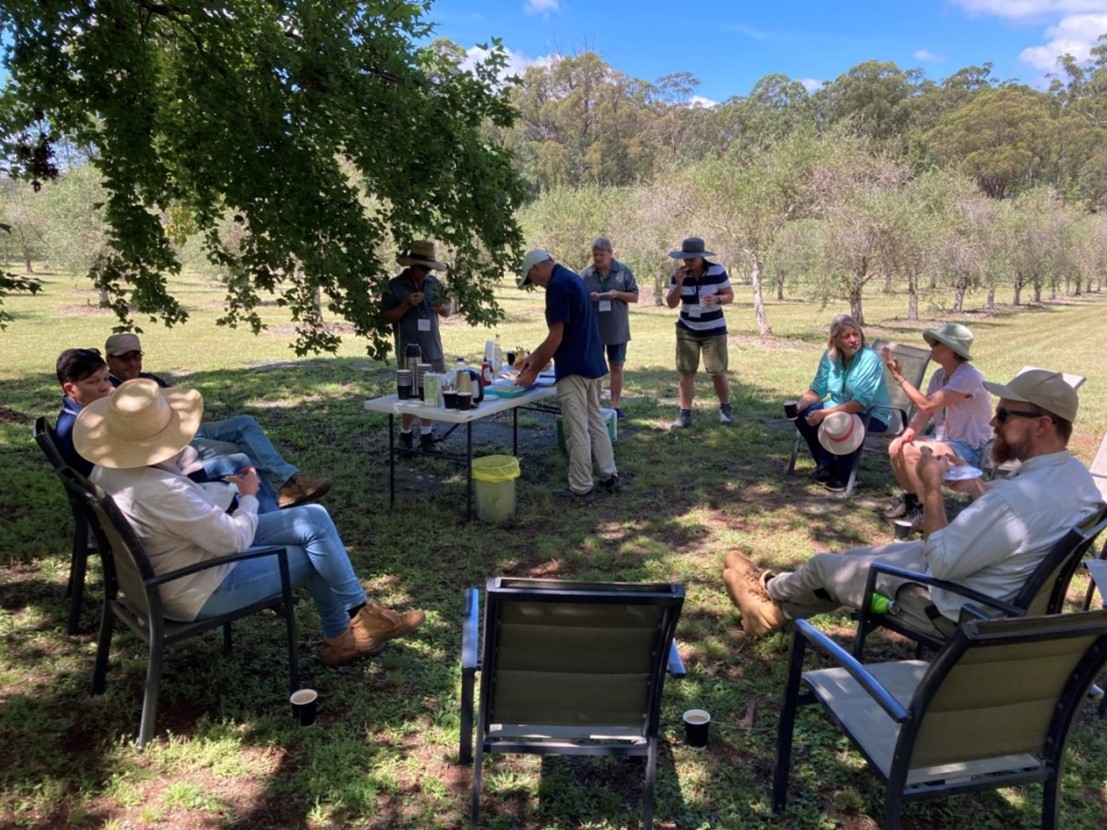
Field day participants enjoying a refreshment break at AFthonia Farms, Hampton QLD
All field day participants were treated to a grove walk that covered important grove productivity topics including practical demonstrations addressing a range of critical grove management issues.
Vanessa Dart described the day as ‘fabulous’, and ‘just in time with all this rain about now’. The resounding take outs from the day are:
1) Do something!
2) Don’t over complicate the processes.
AOA has also received very positive feedback from the other field day participants, and is very interesting to hear how participants have been inspired to do with their field day learnings, and to track the outcomes over coming years.
Download the AFthonia Farms field day report here
At Lisadurne Hill, Rushworth VIC.
Some 41 olive producers from 22 olive groves attended a very successful field day hosted by Lisadurne Hill, located near Rushworth in the historic gold mining region of Central Victoria.
Participants were primarily from nearby regions, although a few producers travelled from the Mornington Peninsula.
AOA CEO Greg Seymour said the participant feedback sheets were extremely positive about the quality of the presenters and their information; and the venue, catering, and organization of the day.
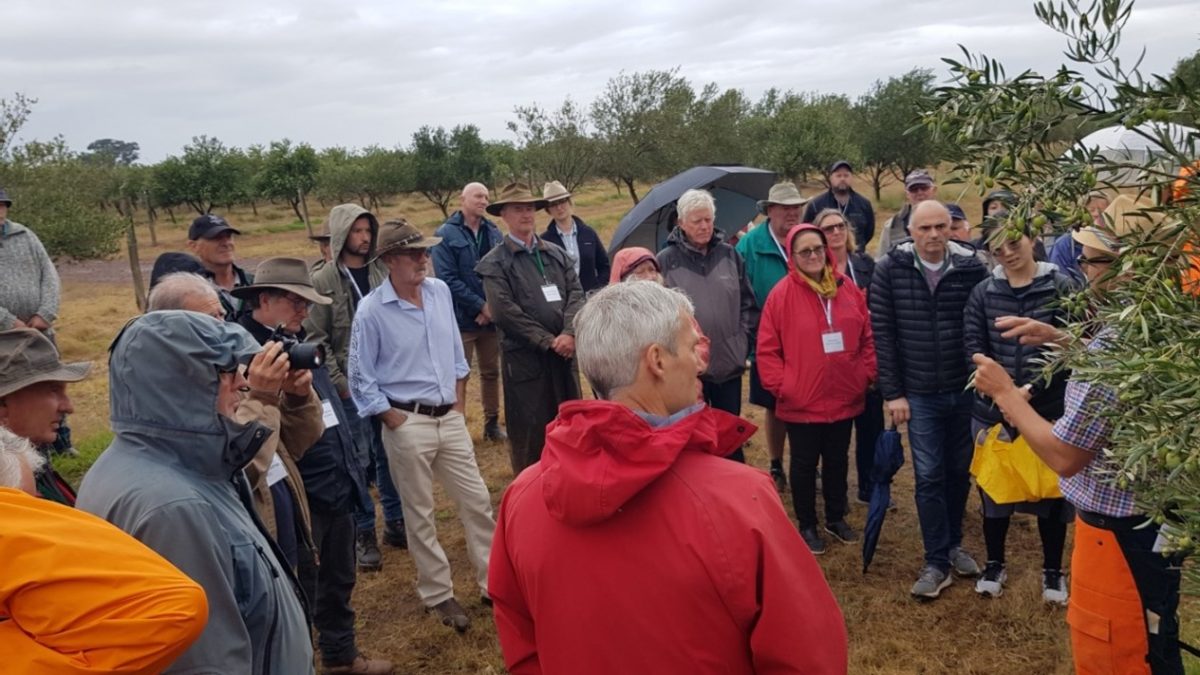
Lisadurne Hill field day participants experienced a damp but stimulating day
The Lisadurne Hill grove:
Run by husband and wife team, Russ and Tina Knight, Lisadurne Hill is a family farm established in Rushworth in the 1870’s. ‘Lisadurne’ now has 27,000 olive trees – planted between 2008 and 2009 – on the Hill Paddock. The grove has seven varieties of olive trees for oil production and two for table olives.
Download the Lisadurne Hill field day report here
At Preston Valley Grove Donnybrook, WA.
Some 28 olive producers and service providers from 16 WA enterprises attended a very successful field day hosted by Preston Valley Grove EVOO producer and AOA Director WA Mick Ryan and his team.
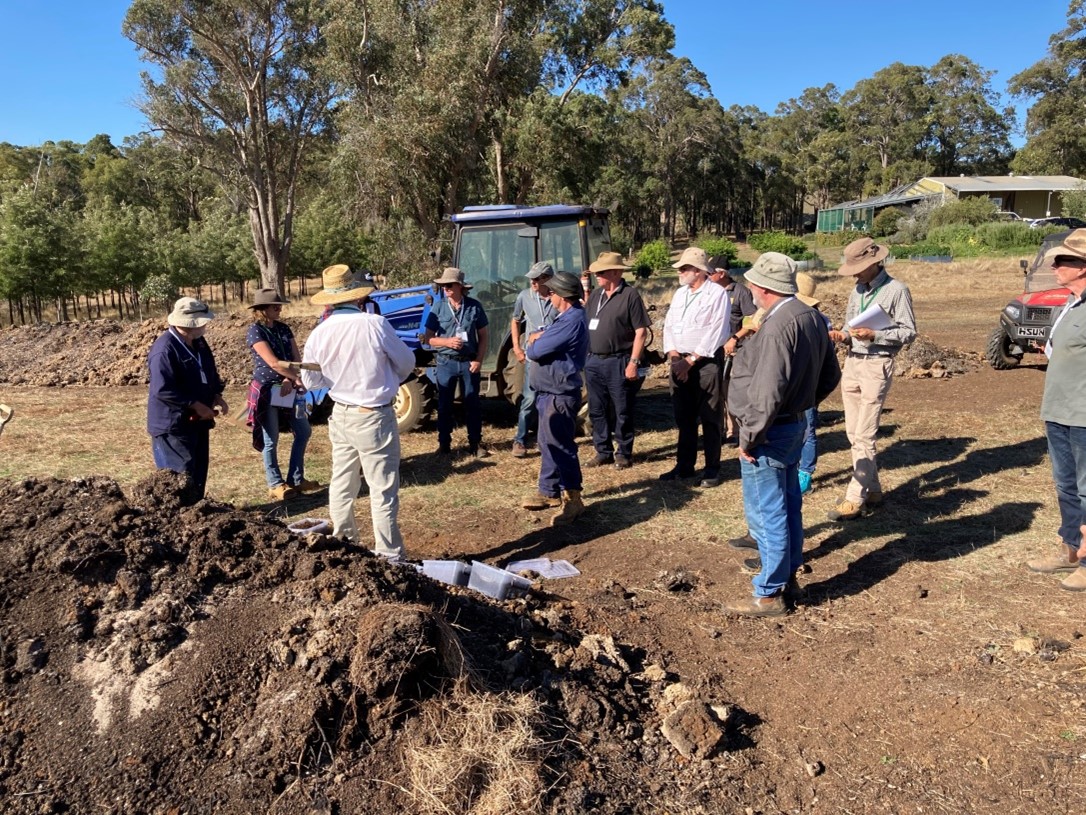
Demonstrating compost making at Preston Valley Grove
The Preston Valley Grove
Preston Valley Grove was purchased in 2003 located 16 km west of Donnybrook in the South West Region of Western Australia, the grove comprises 63 Ha, and currently has a total of 2,500 trees, with the initial planting made in 2003. The principal olive varieties being: Frantoio, Coratina, Minerva, Picual, WA Mission, Correggiola.
In addition to the production of premium EVOO, a range of flavoured olive oils are also made by simultaneously processing the olives with citrus fruit (Agrumato Method) or fresh herbs to produce flavoured olive oil with an unparalleled taste and flavour. All additives to the flavoured oils are produced and grown on the farm.
The property, whilst not organic certified, undertakes a range of sustainable development practices. These include:
- The use of sheep within the olive grove and property to minimise weeds
- The grazing practice employed minimising slashing within the grove
- Recycling the olive waste produced from the Press into compost and adding it back into the grove and pasture minimising import of fertiliser
- The collection of rain water for olive processing
- The maximising of alternate energy sources, e.g. solar and wind, for power generation
- The property is not connected to the regional electricity grid.
- Download Mick Ryan’s presentation on Preston Valley Grove here
- Download the Preston Valley Grove field day report here
The expert demonstrations and presentations varied from field day venue to venue and may have included:
Olive Lace Bug (OLB) in the Hunter Valley
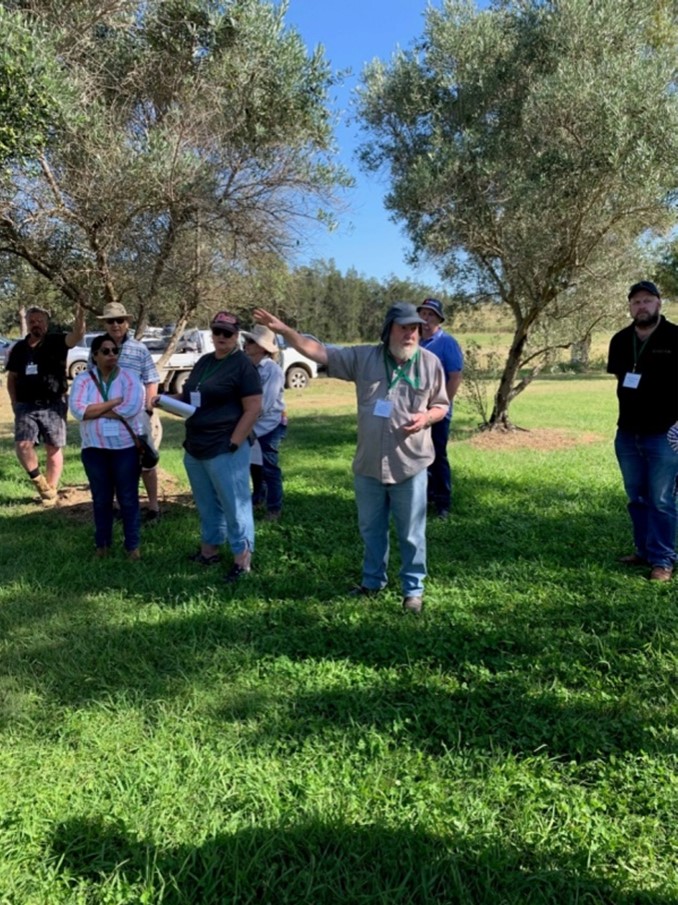
Entomologist Dr Robert Spooner-Hart led discussion around healthy olive trees at Hunter Dream Estate.
Peter Herborn explained that the current outbreak of Olive Lace Bug (OLB) is predominantly in properties bordering the National Park and State Forest. In discussion with Robert Spooner Hart they agreed that one major contributing factors has been the bushfires that destroyed vast areas of the natural habitat of lace bug and its likely natural enemies.
Whilst this was a year ago it is almost certain that large numbers of lace bugs survived over winter, only to re-emerge with high nymphal survival rates in the abnormally wet, warm and humid summer we have recently experienced in the Hunter.
Noting OLB is now a serious problem in the Hunter, Peter Herborn recommends:
- regularly monitor your groves, especially from spring, to detect emergence of the first generation of lace bug nymphs. This is the easiest infestation to target and effectively manage, and will reduce later season problems
- healthy trees are less susceptible and more tolerant of lace bug attack
- don’t put off doing something, especially if you see the start of an infestation
- recognise that use of systemic sprays will have an impact on harvest dates due to WHP requirements. So early intervention with systemic sprays is the best time for this strategy. Later in the season, consider non-systemic alternatives.
- try a containment approach using a pyrethrum/pest oil mix.
- cut out and burn affected branches if possible to do so eg low lying/non-fruit bearing limbs harbouring significant colonies of lace bug nymphs
- be aware that you may get turned away from processors if a) you are unable to confirm you have NOT harvested within the WHP and/or b) there is an obvious presence of lace bug in the delivery
- treat the problem comprehensively post-harvest – don’t allow it perpetuate over winter. Adult lace bugs can survive over winter, as well as eggs laid in olive leaves.
- Access AOA’s technical notes on significant pests and diseases of the olive tree here.
- Access Professor Robert Spooner-Hart’s IPDM project resources here.
Long term strategy for management of Olive Lace Bug Froggattia olivinia

Olive Lace Bug: https://olivebiz.com.au/wp-content/uploads/2020/08/OLIVE-LACE-BUG.pdf
If required, lace bug can be targeted by judicious use of insecticides. Several, including pyrethrum and potassium soap may be organically acceptable inputs. Sprays need to be targeted at young nymphal stages, so monitoring for nymphal hatch of especially the first generation in spring is important. Opening up tree canopies exposes nymphs to greater likelihood of dehydration, and also to access by sprays targeted against them. Stressed trees are more susceptible to lace bug attack, so maintaining healthy trees assists in management of this pest.
AOA technical note on current approved chemical control options for olive lace bug:
- New PER 89943 Trivor Insecticide (acetamiprid + pyriproxyfen) Permit to 31 January 2024, Group 4A (Neonicotinoid) and Group 7C (Insect Growth Regulator) APVMA Permit listing TBA
Maximum of 2 applications per season. Withholding Period 28 days
- PER14897 Clothianidin (Samurai) Permit to 31 March 2023: systemic Group 4A neonicotinoid insecticide, http://permits.apvma.gov.au/PER14897.PDF
Apply one spray only at the nymphal stage. Withholding Period: 56 days
- PER13999 Version 6 Dimethoate Permit to 31 March 2021: contact and systemic Group 1B organophosphorus insecticide, http://permits.apvma.gov.au/PER13999.PDF
Maximum of 4 applications per season. Withholding Period: 42 days.
- PER81949 Esenvalerate (Sumi-Alpha-Flex) Permit to 31 December 2023: broad spectrum Group 3A synthetic pyrethroid insecticide, :https://sumitomo-chem.com.au/sites/default/files/literature/per81949.pdf
Maximum of 4 applications per season. Withholding Period: 14 days. Demonstrated efficacy but disruptive to beneficials.
- PER81870 Pyrethrum (Pyganic): Permit to 31 Oct 2019, broad spectrum Group 3A organic pyrethroid insecticide, (organic certified), http://permits.apvma.gov.au/PER81870.PDF
Maximum of 2 consecutive sprays. Withholding Period: 1 day – trial work currently underway for label registration.
- Pending: Flupyradifurone (SIVANTO) – (Xylem mobile) foliar contact agent and in soil systemic Group 4D butenolide systemic insecticide– IPM compatible – work contracted April 2018, due for completion June 2021 – for OLB control.
Technical Info: https://www.sivanto.bayer.com/doc/Technical-Information-SIVANTO.pdf
Anticipate Use: maximum of 1 application per season. withholding Period: 20 days – TBC.
Other “soft” control options for OLB:
- PER14414 (Natrasoap®) fatty acids – K salt Permit to 30 September 2023: Contact agent http://permits.apvma.gov.au/PER14414.PDF Withholding Period: Nil.
Note: Many growers report that Natrasoap® and its equivalent – potassium salts mixed with spray oil products may not be highly effective.
- Potassium carbonate and potassium bi-carbonate are foliar nutrients that may have incidental contact agent pest control properties.
- Horticultural spray oils are simple, easy to use safely, and are kinder to beneficial insects, but they do depend on the spray fully “wetting” the instars and insects. Since the instars and insects live on the underside of olive leaves, the spray equipment must be set up carefully to saturate the undersides of the leaves right across the tree. Recommended rates of application for spray oils are around 1000 L/ha.
- http://websvr.infopest.com.au/LabelRouter?LabelType=L&Mode=1&ProductCode=59092
Note: Paraffinic and vegetable oils (including olive oil) – contact agents – potential low toxicity organic options – however there are implications for use of vegetable oils close to harvest as this may alter EVOO fatty acid profile test results.
- The native green lacewing Mallada signata is commercially available. Robert Spooner Hart says he “has several times observed in the field lacewing larvae attacking nymphal stages of OLB (including with carcases on their back). But this has been rare, and I have been through many populations of lace bug with no obvious signs of predation, except for occasional spiders”. https://bugsforbugs.com.au/product/lacewing/
Suggested resistance management strategy for the control of Olive Lace Bug (OLB):
(Assuming the grower has legal access to the above Group 1B, 3A, 4A, 4D, 7C pesticides)
- DO NOT apply consecutive sprays of solo products containing Group 4A, consecutive sprays include mixtures containing Group 7C pesticides.
- Consecutive application includes from the end of one season to the start of the following season.
- DO NOT apply consecutive sprays of solo products containing Group 1B, Group 3A, Group 4D pesticides.
- Rotate use of products from Group 1B, Group 3A, Group 4A, Group 4D or Group 7C pesticides.
Harvest timing in the Hunter Valley and other local grove issues:

AOA NSW Director Peter Herborn discussing emerging issues for the coming harvest at Hunters Dream Estate.
Don’t procrastinate – just do it !
A key point that Peter makes is that harvest planning is not a ‘set and forget’ process. Circumstances will change and adjustments are almost inevitable, and it is essential to keep a regular dialogue with harvesters and processors to help anticipate and manage these changes.
Peter led discussion on the following harvest planning points:
- What do you want to achieve? eg olive oil or table or both? Robust or mild oil? Single variety oil? Agrumato oil? Black or green manzanillo etc.
- Do you know how to estimate harvest dates and likely yields.
- Have you thought through your pest and disease control program and required chemical use withholding periods?
- Is your grove well prepared and safe for harvesting / is access readily available?
- Have you thought through grove biosecurity?
- Have you contracted required harvesters / transport / processor?
- Who will handle cleaning of the fruit?
- Have you arranged fruit transport / bins / storage?
- Keep olives clean – avoid contamination of olives with soil, bird droppings, hydraulic oil etc
- Manage ‘field heat” – take care with storage of olive fruit in bins from harvest to milling (consider bin materials, bin storage, fruit depth, ventilation and shading)
- Do you have contingency plans?
Canopy management:
The key canopy management point is that because olive trees fruit on one year old wood, the tree canopy needs to be rejuvenated ideally over a 6-8 year cycle to maximise the volume of young fruiting wood that is exposed to sunlight. This practice also enables the height of the trees to be lowered, making groves more manageable for pest and disease control and harvest.

With renovation pruning between 25-30% of the canopy can be removed with a single cut between shoulder and waste height on the North facing side of the tree in the first year. This will serve to reduce the height of the tree and stimulate regrowth around the cut that over time will produce new leaders. By removing this limb light will also better penetrate the remainder of the canopy and increase the growth of fruiting wood, and improve fruit set on the remainder of the tree, meaning overall crop yield should increase – not reduce over time.
At the TAS, SA and VIC field days, olive grove specialist Andrew Taylor explained and demonstrated:
- Pruning for sunlight/shade pattern
- Pruning for tree row volume
- Pruning for harvest method
- Pruning for leaf/wood ratio
- Pruning as cultural practise for disease control
- Pruning for renewal
- Pruning for frost reduction
- Pruning for consistent production
- View Andrew Taylor’s video on olive tree pruning and disease management Video (7.5 mins).
- Read about the Wollundry Grove canopy renovation program in the Australian & New Zealand Olivegrower and processor: June 2020 edition – pp14-17. Also available on-line to subscribers at: https://olivebiz.com.au/magazines/olivegrower/back-issues/
Reference: ‘Olive Growing’ manual (El Cultivo Del Olivo) (RIRDC Publication 09-067, October 2010).2 – Chapter 12 – Pruning
Soil moisture and temperature monitoring and on-farm weather stations:
Tass Peters (OneTemp) hardware & Tom Nelligan (Swan Systems) software
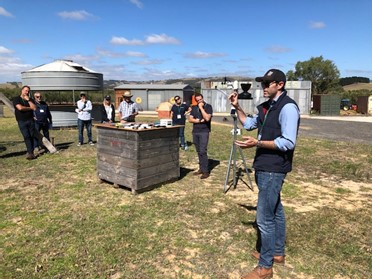
Tom Nelligan explaining the application of ‘precision irrigation’ using a OneTemp farm weather station and monitoring equipment and Swan Systems software at Nangkita Estate, SA.
Tass Peters of SA based One Temp is currently providing Environmental monitoring solutions to measure, record, and manage data for enhancing environments throughout Australia and New Zealand.
View the range of OneTemp data loggers at: https://www.onetemp.com.au/all-data-loggers
Tom Nelligan of WA based Swan Systems has recently completed a Master in Agribusiness from the University of Adelaide. Prior to returning to his studies Tom worked as an agronomist and as an agribusiness consultant. Tom joined SWAN Systems in early 2020 as its Key Account Manager in South Australia and for the Sunraysia district in Victoria and New South Wales.
View the range of Swan Systems water and nutrient management systems at: https://www.swansystems.com.au/industries/horticulture/
Tom and Tass explained and demonstrated:
- Application of remote sensing – soil moisture, temperature, automation and Weather Station Configurations.
- Monitoring of soil moisture/Temperature/ conductivity and evaporation, Soil Water Potential monitoring.
- Calculated Weather Channels – Evapotranspiration, Accumulated Rainfall and Dew point.
- Frost Monitoring.
- Irrigation monitoring and control.
SWAN Systems is a precision irrigation management tool which utilises your existing farm hardware to calculate your soil moisture balance. We use irrigation and weather data, as well as block specific soil characteristics, to create a digital model of your soil moisture. By using the BOM’s gridded weather forecast, we can predict where your soil moisture balance will be in 7 days, enabling you to accurately plan irrigation around forecast rain and weather, saving you time, energy and resources.
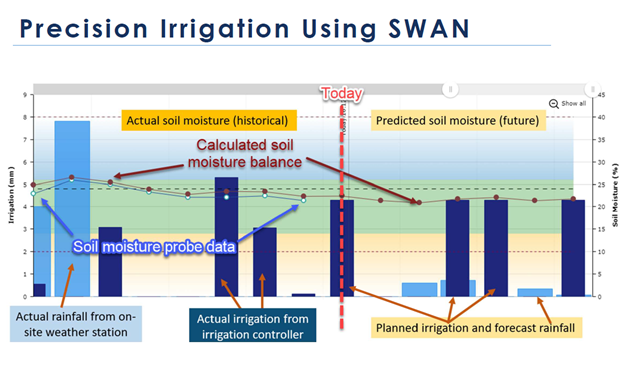
Download ‘Precision Irrigation Using SWAN’ chart here.
View OneTemp demonstration of weather stations, remote sensing and automation at Nangkita Grove Video (14 min)
Soil health and leaf and soil nutrition monitoring
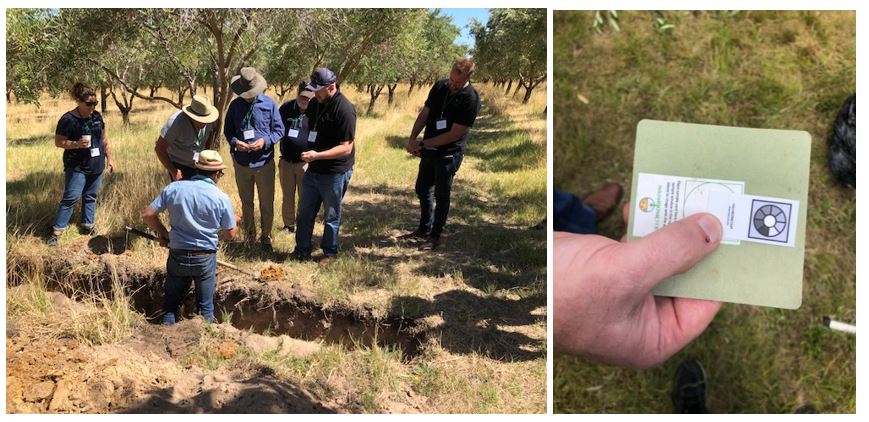
Peter Briscoe and Shaune Amber from Bioptiv Australia examining a soil trench at Nangkita Grove prepared by Andrew Taylor & demonstrating the ‘microbiometer’ that measures the ratio of soil bacteria to fungi
Peter Briscoe is head of global sales for Bioptiv Australia, based in Victoria, and Shaune Amber is national sales manager based in SA for Bioptiv Australia, which has the IP, licenses, permits, product range and customer base of Bioactive Soil Solutions and continuing the 10+ years of great work that Bioactive Soil Solutions began in the agricultural biological industry. Bioptiv has a range of exciting new initiatives to ensure that they can provide a more holistic approach to biological farming methods and soil improvement amendments including an expanded range of biological offerings and plant based carbon products.
Chris Weiman is Business Development – Agriculture at C-Wise in WA
An important point made by the presenters is that it is essential for growers to simultaneously undertake both soil and leaf analysis, including soil pH to enable a more accurate diagnosis of actual nutrient deficiency, and in designing a grove nutrition program. Sample the same soil sites and trees at least annually to enable comparable data and to read trends.
The following points were explained:
- How do you maintain productive groves while streamlining nutrient requirements?
- How do you manage applications of fertilisers to optimise plant uptake and minimise losses to run-off, leaching or gas emissions?
- When should I take soil and leaf tests?
- Why is soil pH important?
- What fertiliser methods should I use?
- How do I improve soil biology and carbon in my soils?
- Building soil nitrogen and nitrogen fixation
- The use of soil amendments to correct sodic and acidic soils
- Download Bioptiv talking points on soil health and grove nutrition here.
- Download Bioptiv notes on taking soil samples for analysis here and taking leaf samples for analysis here.
- Download C-Wise notes on taking soil samples and leaf samples for analysis here
- Download C-Wise presentation on interpreting soil and leaf analysis reports here
The Bactivate Program:
- Download Bioptiv report on Longridge Olives (SA) Bactivate Program from 2015 – 2020 here.
The Bactivate Program is designed to add specific microbes required for nutrition conversion, plant immune health and growth by adding in key Bacillus bacteria in an antagonistic form while feeding those microbes, initiating soil structure improvements and driving increased cropping outcomes for a long-term sustainable solution. This report looks at soil and leaf analysis results over a 5 year treatment period.
Click on the above link and read on.
References:
- ‘Olive Growing’ manual (El Cultivo Del Olivo) (RIRDC Publication 09-067, October 2010).2 – Chapter 9 – Fertilization
- ‘Organic Olive Production Manual’ by Paul Vossen, available for purchase through various on-line booksellers ($20) – Chapter 5 – Organic Olive orchard Nutrition
Making and using compost
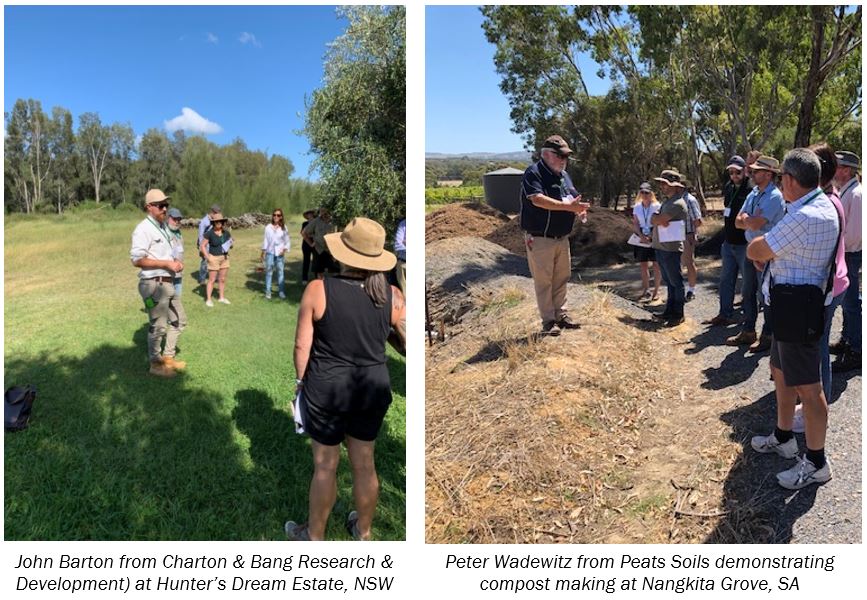
Peter Wadewitz is the Managing Director of both Peats Soils & BiobiN® Technologies, and the chair of the Australian Organics Recycling Association (aora). In 2020 Peter was awarded a Medal of the Order of Australia (OAM) for his services to the organic recycling industry. Peter’s interest in mulch started some 45 years ago when he started collecting bark offcuts for timber yards on the weekends with his shovel and trailer. Then he started collecting compost and made potting mix from his Dad’s nursery in Plympton. He would bag it up into clear bags. The name “Peats Soil” came about when one of the staff suggested that it had peat in it, and Pete made it so why don’t you call it Peats Soil?
John Barton from Charton & Bang Research & Development grew up on a rice farm near Griffith, NSW and worked in agriculture across a range of crop types. After sustaining a back injury John retrained in horticultural science, specialising in soil function and farm ecosystems. He has worked for 10 years in commercial composting at every level from machinery operator to business owner. He has been involved in the production of 1 million cubic metres of compost and has been involved in the commissioning and staff training of 5 new composting sites around Australia. John is passionate about creating sustainable farms and soils that can produce food forever with degrading.
Andy Gulliver is a mushroom farmer turned entrepreneur and a cofounder of Western Australian company C-Wise, which transforms organic carbon into compost. Started in 1996 as Custom Composts by Andy Gulliver and Dave Cullen, the business revolves around the idea that ‘in ten years’ time, we will have made a difference. The difference we are looking to make is creating a world in which organic carbon is truly valued. Valued organic carbon would mean never letting it go to landfill, it would mean managing soils with the goal of maintaining and improving soil organic carbon, and it would mean that we would do these things not just for a warm and fuzzy feeling, but because we don’t think that there is really any other choice.
The presenters explained and demonstrated:
- Composting
- Compost recipe
- Compost application rates
- Soil water
- Collecting more water
- Holding more water
- Giving back more water
- Soil carbon
- Living carbon
- Simple carbon
- Complex carbon
- How we lose soil carbon
- How we can build soil carbon
- How to keep soil carbon
- Measuring soil carbon

Andy Gulliver (C-Wise) explaining the finer points of making and using high quality compost at Preston Valley Grove, WA.
- Download John Barton’s (Charton & Bang, Research & Development) talking points on composting and soil carbon here.
- Download Andy Gulliver’s (C-Wise) presentation on soil carbon here
- Download Compost for Soils trial at Regans Ford olive grove WA here, and Guide your Compost Application here.
- View Peats Soils agricultural solutions at: https://www.peatssoil.com.au/agricultural-solutions/
- ‘Organic Olive Production Manual’ by Paul Vossen, available for purchase through various on-line booksellers ($20) – Chapter 9 – Agricultural Use of Olive Mill Waste.
- For more information on compost and composting click here
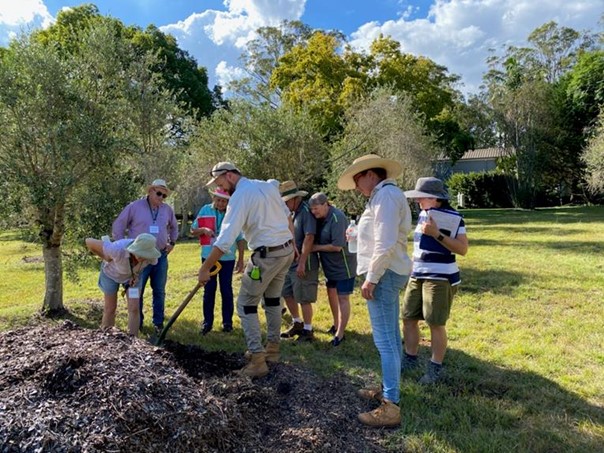
John Barton from (Charton & Bang, Research & Development) explaining the finer points of making and using high quality compost at aFthonia Farms, Hampton QLD
